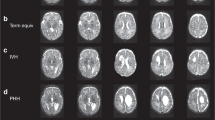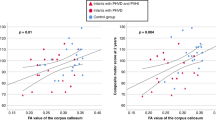Abstract
Background
Despite treatment with therapeutic hypothermia, hypoxic–ischemic encephalopathy (HIE) is associated with adverse developmental outcomes, suggesting the involvement of subcortical structures including the thalamus and basal ganglia, which may be vulnerable to perinatal asphyxia, particularly during the acute period. The aims were: (1) to examine subcortical macrostructure in neonates with HIE compared to age- and sex-matched healthy neonates within the first week of life; (2) to determine whether subcortical brain volumes are associated with HIE severity.
Methods
Neonates (n = 56; HIE: n = 28; Healthy newborns from the Developing Human Connectome Project: n = 28) were scanned with MRI within the first week of life. Subcortical volumes were automatically extracted from T1-weighted images. General linear models assessed between-group differences in subcortical volumes, adjusting for sex, gestational age, postmenstrual age, and total cerebral volumes. Within-group analyses evaluated the association between subcortical volumes and HIE severity.
Results
Neonates with HIE had smaller bilateral thalamic, basal ganglia and right hippocampal and cerebellar volumes compared to controls (all, p < 0.02). Within the HIE group, mild HIE severity was associated with smaller volumes of the left and right basal ganglia (both, p < 0.007) and the left hippocampus and thalamus (both, p < 0.04).
Conclusions
Findings suggest that, despite advances in neonatal care, HIE is associated with significant alterations in subcortical brain macrostructure.
Impact
-
Compared to their healthy counterparts, infants with HIE demonstrate significant alterations in subcortical brain macrostructure on MRI acquired as early as 4 days after birth.
-
Smaller subcortical volumes impacting sensory and motor regions, including the thalamus, basal ganglia, and cerebellum, were seen in infants with HIE.
-
Mild and moderate HIE were associated with smaller subcortical volumes.
This is a preview of subscription content, access via your institution
Access options
Subscribe to this journal
Receive 14 print issues and online access
$259.00 per year
only $18.50 per issue
Buy this article
- Purchase on Springer Link
- Instant access to full article PDF
Prices may be subject to local taxes which are calculated during checkout


Similar content being viewed by others
Data availability
The data supporting this study’s findings are available from the corresponding author upon reasonable request.
References
Lee, A. C. et al. Intrapartum-related neonatal encephalopathy incidence and impairment at regional and global levels for 2010 with trends from 1990. Pediatr. Res. 74(Suppl 1), 50–72 (2013).
Gunn, A. J. & Bennet, L. Fetal hypoxia insults and patterns of brain injury: insights from animal models. Clin. Perinatol. 36, 579–593 (2009).
Lee, B. L. & Glass, H. C. Cognitive outcomes in late childhood and adolescence of neonatal hypoxic-ischemic encephalopathy. Clin. Exp. Pediatr. 64, 608–618 (2021).
Kurinczuk, J. J., White-Koning, M. & Badawi, N. Epidemiology of neonatal encephalopathy and hypoxic-ischaemic encephalopathy. Early Hum. Dev. 86, 329–338 (2010).
Sarnat, H. B. & Sarnat, M. S. Neonatal encephalopathy following fetal distress. A clinical and electroencephalographic study. Arch. Neurol. 33, 696–705 (1976).
Mrelashvili, A., Russ, J. B., Ferriero, D. M. & Wusthoff, C. J. The Sarnat score for neonatal encephalopathy: looking back and moving forward. Pediatr. Res. 88, 824–825 (2020).
de Vries, L. S. & Cowan, F. M. Evolving understanding of hypoxic-ischemic encephalopathy in the term infant. Semin. Pediatr. Neurol. 16, 216–225 (2009).
Jacobs, S. E. et al. Cooling for newborns with hypoxic ischaemic encephalopathy. Cochrane Database Syst. Rev. 2013, CD003311 (2013).
Wintermark, P., Mohammad, K. & Bonifacio, S. L. & Newborn Brain Society Guidelines and Publications Committee. Proposing a care practice bundle for neonatal encephalopathy during therapeutic hypothermia. Semin. Fetal Neonatal Med. 26, 101303 (2021).
de Vries, L. S. & Groenendaal, F. Patterns of neonatal hypoxic-ischaemic brain injury. Neuroradiology 52, 555–566 (2010).
Parikh, N. A. et al. Volumetric and anatomical MRI for hypoxic-ischemic encephalopathy: relationship to hypothermia therapy and neurosensory impairments. J. Perinatol. 29, 143–149 (2009).
Shapiro, K. A. et al. Early changes in brain structure correlate with language outcomes in children with neonatal encephalopathy. Neuroimage Clin. 15, 572–580 (2017).
Annink, K. V. et al. The long-term effect of perinatal asphyxia on hippocampal volumes. Pediatr. Res. 85, 43–49 (2019).
Bregant, T. et al. Region-specific reduction in brain volume in young adults with perinatal hypoxic-ischaemic encephalopathy. Eur. J. Paediatr. Neurol. 17, 608–614 (2013).
Lemyre, B. & Chau, V. Hypothermia for newborns with hypoxic-ischemic encephalopathy. Paediatr. Child Health 23, 285–291 (2018).
Hughes, E. J. et al. A dedicated neonatal brain imaging system. Magn. Reson. Med. 78, 794–804 (2017).
Papile, L. A., Burstein, J., Burstein, R. & Koffler, H. Incidence and evolution of subependymal and intraventricular hemorrhage: a study of infants with birth weights less than 1,500 gm. J. Pediatr. 92, 529–534 (1978).
Zollei, L., Iglesias, J. E., Ou, Y., Grant, P. E. & Fischl, B. Infant FreeSurfer: an automated segmentation and surface extraction pipeline for T1-weighted neuroimaging data of infants 0-2 years. Neuroimage 218, 116946 (2020).
Sun, X. et al. Histogram-based normalization technique on human brain magnetic resonance images from different acquisitions. Biomed. Eng. Online 14, 73 (2015).
de Macedo Rodrigues, K. et al. A FreeSurfer-compliant consistent manual segmentation of infant brains spanning the 0-2 year age range. Front. Hum. Neurosci. 9, 21 (2015).
Iglesias, J. E. & Sabuncu, M. R. Multi-atlas segmentation of biomedical images: a survey. Med. Image Anal. 24, 205–219 (2015).
Knickmeyer, R. C. et al. A structural MRI study of human brain development from birth to 2 years. J. Neurosci. 28, 12176–12182 (2008).
Raguz, M. et al. Structural changes in the cortico-ponto-cerebellar axis at birth are associated with abnormal neurological outcomes in childhood. Clin. Neuroradiol. 31, 1005–1020 (2021).
Sabir, H. et al. Unanswered questions regarding therapeutic hypothermia for neonates with neonatal encephalopathy. Semin. Fetal Neonatal Med. 26, 101257 (2021).
Spencer, A. P. C. et al. Brain volumes and functional outcomes in children without cerebral palsy after therapeutic hypothermia for neonatal hypoxic-ischaemic encephalopathy. Dev. Med. Child Neurol. 65, 367–375 (2023).
Miller, S. P. et al. Patterns of brain injury in term neonatal encephalopathy. J. Pediatr. 146, 453–460 (2005).
Misser, S. K. et al. A proposed magnetic resonance imaging grading system for the spectrum of central neonatal parasagittal hypoxic-ischaemic brain injury. Insights Imaging 13, 11 (2022).
Roland, E. H., Poskitt, K., Rodriguez, E., Lupton, B. A. & Hill, A. Perinatal hypoxic-ischemic thalamic injury: clinical features and neuroimaging. Ann. Neurol. 44, 161–166 (1998).
Mota-Rojas, D. et al. Pathophysiology of perinatal asphyxia in humans and animal models. Biomedicines 10, 347 (2022).
Gooijers, J. et al. Subcortical volume loss in the thalamus, putamen, and pallidum, induced by traumatic brain injury, is associated with motor performance deficits. Neurorehabil. Neural Repair 30, 603–614 (2016).
Torrico, T. J. & Munakomi, S. Neuroanatomy, Thalamus (StatPearls, 2022).
Schneider, J. et al. Procedural pain and oral glucose in preterm neonates: brain development and sex-specific effects. Pain 159, 515–525 (2018).
Ilves, N. et al. Ipsilesional volume loss of basal ganglia and thalamus is associated with poor hand function after ischemic perinatal stroke. BMC Neurol. 22, 23 (2022).
Nivins, S. et al. Associations between neonatal hypoglycaemia and brain volumes, cortical thickness and white matter microstructure in mid-childhood: an MRI study. Neuroimage Clin. 33, 102943 (2022).
Geva, S. et al. Volume reduction of caudate nucleus is associated with movement coordination deficits in patients with hippocampal atrophy due to perinatal hypoxia-ischaemia. Neuroimage Clin. 28, 102429 (2020).
Martinez-Biarge, M. et al. Predicting motor outcome and death in term hypoxic-ischemic encephalopathy. Neurology 76, 2055–2061 (2011).
Loh, W. Y. et al. Neonatal basal ganglia and thalamic volumes: very preterm birth and 7-year neurodevelopmental outcomes. Pediatr. Res. 82, 970–978 (2017).
Iwata, O. et al. “Therapeutic time window” duration decreases with increasing severity of cerebral hypoxia-ischaemia under normothermia and delayed hypothermia in newborn piglets. Brain Res. 1154, 173–180 (2007).
Morales, M. M. et al. Association of Total Sarnat Score with brain injury and neurodevelopmental outcomes after neonatal encephalopathy. Arch. Dis. Child. Fetal Neonatal Ed. 106, 669–72. (2021).
Allen, K. A. & Brandon, D. H. Hypoxic ischemic encephalopathy: pathophysiology and experimental treatments. Newborn Infant Nurs. Rev. 11, 125–133 (2011).
Sorokan, S. T., Jefferies, A. L. & Miller, S. P. Imaging the term neonatal brain. Paediatr. Child Health 23, 322–328 (2018).
Paolicelli, R. C. et al. Synaptic pruning by microglia is necessary for normal brain development. Science 333, 1456–1458 (2011).
Perlman, J. M. Intrapartum hypoxic-ischemic cerebral injury and subsequent cerebral palsy: medicolegal issues. Pediatrics 99, 851–859 (1997).
Ursini, G. et al. Convergence of placenta biology and genetic risk for schizophrenia. Nat. Med. 24, 792–801 (2018).
Hagberg, H., Gressens, P. & Mallard, C. Inflammation during fetal and neonatal life: implications for neurologic and neuropsychiatric disease in children and adults. Ann. Neurol. 71, 444–457 (2012).
Barkovich, A. J. et al. Proton spectroscopy and diffusion imaging on the first day of life after perinatal asphyxia: preliminary report. AJNR Am. J. Neuroradiol. 22, 1786–1794 (2001).
Acknowledgements
We thank the NICU families who participated in this study.
Funding
This study was financially supported by the Whaley and Harding Fellowship from the Children’s Health Foundation, Canada First Research Excellence Fund (BrainsCAN), and the Molly Towell Perinatal Research Foundation.
Author information
Authors and Affiliations
Contributions
L.M.N.K., B.K., P.C.M., P.M., K.F., T.A., E.S.N., S.B., S.d.R., L.T., M.J., and E.G.D. were involved in the study design, database variable creation, and data acquisition design and execution of the data analytic strategy and reviewed and/or revised the final version of the manuscript. L.M.N.K., B.K., and E.G.D. contributed to the execution of the data analytic strategy, analyzed the data, and wrote the initial draft of the manuscript. All authors approved the final manuscript as submitted and agree to be accountable for all aspects of the work.
Corresponding author
Ethics declarations
Competing interests
The authors declare no competing interests.
Ethics approval and consent to participate
Consent was obtained from guardians.
Additional information
Publisher’s note Springer Nature remains neutral with regard to jurisdictional claims in published maps and institutional affiliations.
Supplementary Information
Rights and permissions
Springer Nature or its licensor (e.g. a society or other partner) holds exclusive rights to this article under a publishing agreement with the author(s) or other rightsholder(s); author self-archiving of the accepted manuscript version of this article is solely governed by the terms of such publishing agreement and applicable law.
About this article
Cite this article
Kebaya, L.M.N., Kapoor, B., Mayorga, P.C. et al. Subcortical brain volumes in neonatal hypoxic–ischemic encephalopathy. Pediatr Res 94, 1797–1803 (2023). https://doi.org/10.1038/s41390-023-02695-y
Received:
Revised:
Accepted:
Published:
Issue Date:
DOI: https://doi.org/10.1038/s41390-023-02695-y



